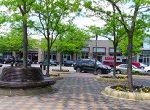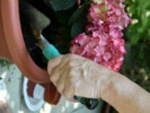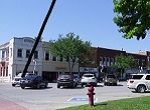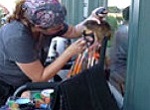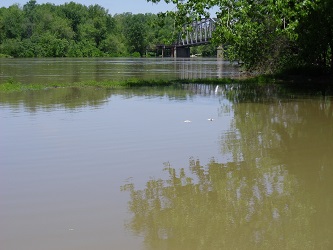How to Plan a Successful Community Mural Project
Last Updated: June 19, 2024
A community mural can serve many functions, including brightening an otherwise boring building facade, creating or reinforcing an identity for a town or district, hinting at the history of an area or building, and even creating work for aspiring or starving artists. Below we will be showing you some different styles.
Occasionally we have even seen a community mural fall short of the expectations of neighborhood or town leaders though. In this article we describe the five most important factors in planning and implementing a successful project.
If your goal is to honor or refer to the history of a specific building or site, obviously you are limited in your choices. Still go through our checklist below, and if the best location on the building does not fare well, maybe you should find another way to interpret your history. Sidewalk plaques or interpretive signs may be more appropriate.
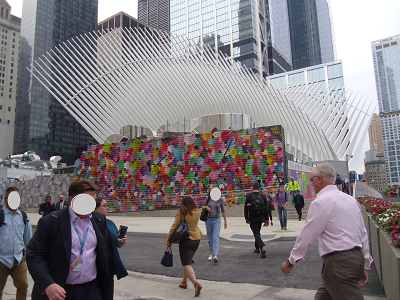 Mural at the Oculus transportation hub at World Trade Center, New York
Mural at the Oculus transportation hub at World Trade Center, New York1. Choose Your Location Carefully.
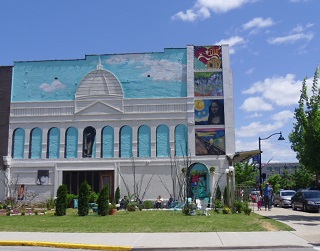 In Belleville, Illinois, a combination of small community murals at the upper right with trompe l'oeil painting on the side of the building next to a vacant corner lot, a good spot for this type of art.
In Belleville, Illinois, a combination of small community murals at the upper right with trompe l'oeil painting on the side of the building next to a vacant corner lot, a good spot for this type of art.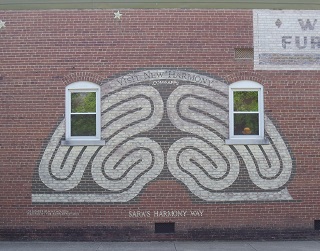 This work manages to capture a symbol of New Harmony, Indiana, plus its tourism slogan and the name of the business. It sits at the most important intersection of small town where visibility is high.
This work manages to capture a symbol of New Harmony, Indiana, plus its tourism slogan and the name of the business. It sits at the most important intersection of small town where visibility is high.Considerations for finding the best location include the following:
- Visibility from passing cars, trucks, and transit vehicles. In general, we would suggest the maximum number of eyeballs on your beautiful community mural, but there might be exceptions. Proximity to a particular intersection, building, park, quiet bench, plaza, or historic site may be more important than the number of less interested folks who will see it.
- Visibility to pedestrians, bicyclists, scooter riders, and wheelchair users.
- Potential for distracted driving. Typically this is not a factor, but it is possible that what you plan would be so unexpected, disturbing, or shiny that traffic safety would dictate another location due to the possibility of sudden slow-downs.
- Enthusiasm and accessibility of the property owner. A reluctant or remorseful property owner can make it difficult to complete and maintain the project, so if there is any doubt, it is usually best to find another location. A property owner who is out of the country or otherwise difficult to contact could edge you toward a different location.
- Distance from and relationship to other town murals already in existence or that you would like to see in the future. Grouping many murals into a district might be quite advantageous if the murals are to be an important aspect of branding your town or neighborhood. However, if you are just trying to add artistic punch, consider carefully your overall daydream for other murals and avoid over-exposure. You also may want to avoid dramatic style differences in murals.
- Climate factors. If your area is subject to driving rains from the north, for example, your mural may decay faster on a north elevation than a south one. Sun fading also may or may not be important, depending on your expectations about the life of the mural, the medium used, and the need for sharpness as part of the artistic vision.
- Relationship between mural size and budget. We like to see a community mural cover about one story in height or almost all of the elevation. If you are choosing between a two-story building and a five-story building, there may be considerable cost differential between the two if you plan to cover the entire wall. We have to add that like most artistic principles, this one is made to be broken, but in general the most memorable murals we have seen follow this "fill the wall" dictum or look purposefully smaller than the entire wall.
- Community preferences. Notwithstanding all of this good advice we have given you, if the community feels strongly about one location over another, it may be best to make the popular choice. After all, do you want to alienate your own community members to attract outside attention? The extent to which you involve the public in this decision depends on whether a public or private entity is footing the bill, but we would hope even a business association or elite civic league would give some weight to popular opinion.
The presence or absence of murals in an historic district may be a particularly sensitive issue, and one that occasionally divides historic preservation-minded folks. If this consideration will be strong in your urban community, check out this article about the Pilsen neighborhood in Chicago and then poke around the rest of that website for other articles showing examples of this artistic medium.
2. Select an artist Quickly.
Find your artist as soon as you solidify your general location, budget, and goals for the town mural. If nurturing your homegrown artist community is a community goal, make sure that you consider all the choices from within that community in an open and transparent process. If you don't, prepare to face backlash later.
However, in adhering to this principle you could end up with an equally disastrous result if you select an artist who has never painted a mural or even a large picture before. Be cautious before offering the commission to someone who does not know this medium. A talented sculptor can't really translate that technical skill to painting the side of a building.
Otherwise, we've described the process of selecting an artist for creating a work of public art in our art in public places page, and we encourage you to follow that advice.
Early selection of the artist can help you spot potential problems before plans become too firm to change. The artist may even find a fatal flaw in what you plan, so don't let expectations soar before you have actually chosen the person who will paint your community mural.
If you think nothing can go wrong, check out three below where some good ideas may have been thwarted by lack of building access or inappropriate design. You may have to enlarge your view to see.
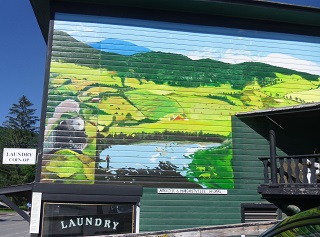 Arkville, New York
Arkville, New York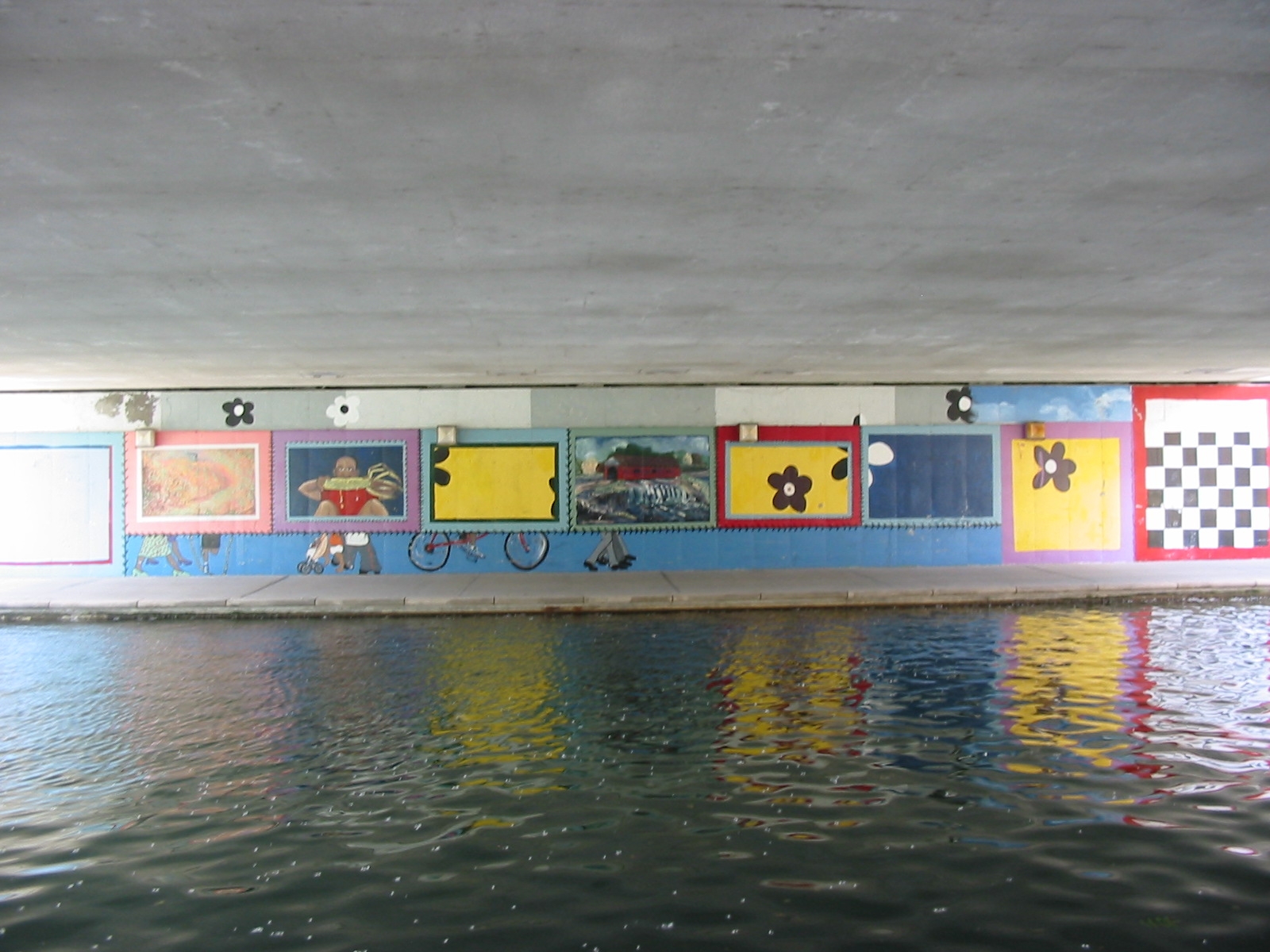 Indianapolis, Indiana
Indianapolis, Indiana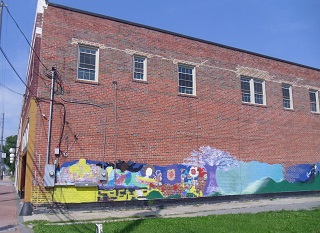 Hampton, Virginia
Hampton, Virginia3. Execute a Proper Easement or Contract with the Building Owner.
Your city attorney or an attorney working with your neighborhood association, arts district, or business district can provide specific advice for your location. The goal of the agreement should be to protect the community against the destruction of a community mural at the whim of a property owner, as well as to guarantee access to the facade during painting and maintenance. Address situations such as the ones below.
Is the property owner obligated to retain the mural when other building maintenance is undertaken? Or may that owner paint over or sandblast the mural?
Is there a time limit on the property owner's obligation to keep the mural intact?
What happens if the brick, stucco, or siding under the mural starts to fail?
What happens if the building is condemned for structural reasons? You might think this could not happen because you have chosen a well-maintained building, but what about earthquakes, fires, and tornadoes?
If the building owner maintains a lawn or owns a parking lot or vacant lot next to the facade where the mural will be painted, is the owner required to keep that space open so people can see the mural better?
How are responsibilities of the property owner to be continued if the building is sold or ownership passes on to heirs? We want to note here that it is this consideration that causes us to conclude that an easement giving specific rights to the sponsor of the mural is far superior to a simple contract. Easements are publicly recorded and should be revealed in the course of a sale, while contracts may or may not come to light and would not bind a new owner.
I suppose a deed restriction is another option, but that seems like overkill for this situation.
You want to settle questions such as these: Does the mural sponsor have the right to remove the mural, and if so, under what circumstances? Think about a newly revealed scandal, a cultural or political change of heart, or the possibility that the community mural will need maintenance that the sponsor cannot afford or chooses not to undertake. Thinking through this provision could help resolve a future situation in which a property owner has grown fond of the mural or maybe uses it in their own branding, but the community mural sponsor wants to move on to another emphasis.
Who is responsible for maintaining the appearance of the community mural when paint starts to peel? Who decides that maintenance is required? Does the building owner get to dictate that, or is that decision solely at the sponsoring organization's discretion?
4. Make the most of the Community Mural As Outreach.
Attract attention to the upcoming mural as soon as appropriate for your situation. If you represent a public entity or one that requires approval from a public official or board, involve the public very early in discussions of the what, why, where, and how of your mural. If the mural needs to be more of a surprise, such as unveiling for a special occasion, for example, you still want to build anticipation and curiosity.
Some artists welcome spectators as they work, and others prefer not to have the potential distraction. This factor may influence your choice of when to provide a social media push and other outreach. Some artists may want parts of the finished work obscured until the work is complete. However, given the likely importance of social media in making your mural statement even stronger, try for a steady barrage of Instagram and Facebook posts as the work takes shape.
In all cases though be ready with a celebration when the mural is finished. If this is the first town mural in your location, it calls for the mayor and representatives of all involved organizations to participate in an unveiling or dedication ceremony. In a business district, you may want prizes, coupons, food trucks, or giveaways for spectators. Be sure to invite the artist, all elected officials, all organizations and congregations active in the area, the media, descendants of any historical figure depicted, and the immediate neighbors, whether businesses or residents. Consider inviting artists that you did not select, keeping them interested in your community.
If you have several murals and a robust neighborhood or district publicity program already, your response can be more subdued. You still want to have a smaller ceremony to honor the completion of the new addition.
5. A Mural Is Not a Cure-All.
For this last section, we want to tell you about the small town of Cuba, Missouri, which commissioned 12 community murals about its past and present in honor of its 150th anniversary. A couple more have been added since. Overall we think this program of a beautification organization, Viva Cuba, has been quite successful. Immediately below we show you some of their handiwork in context. Then keep scrolling down to see why this town also is an illustration of the principle that a public art project does not take care of all community beautification issues.
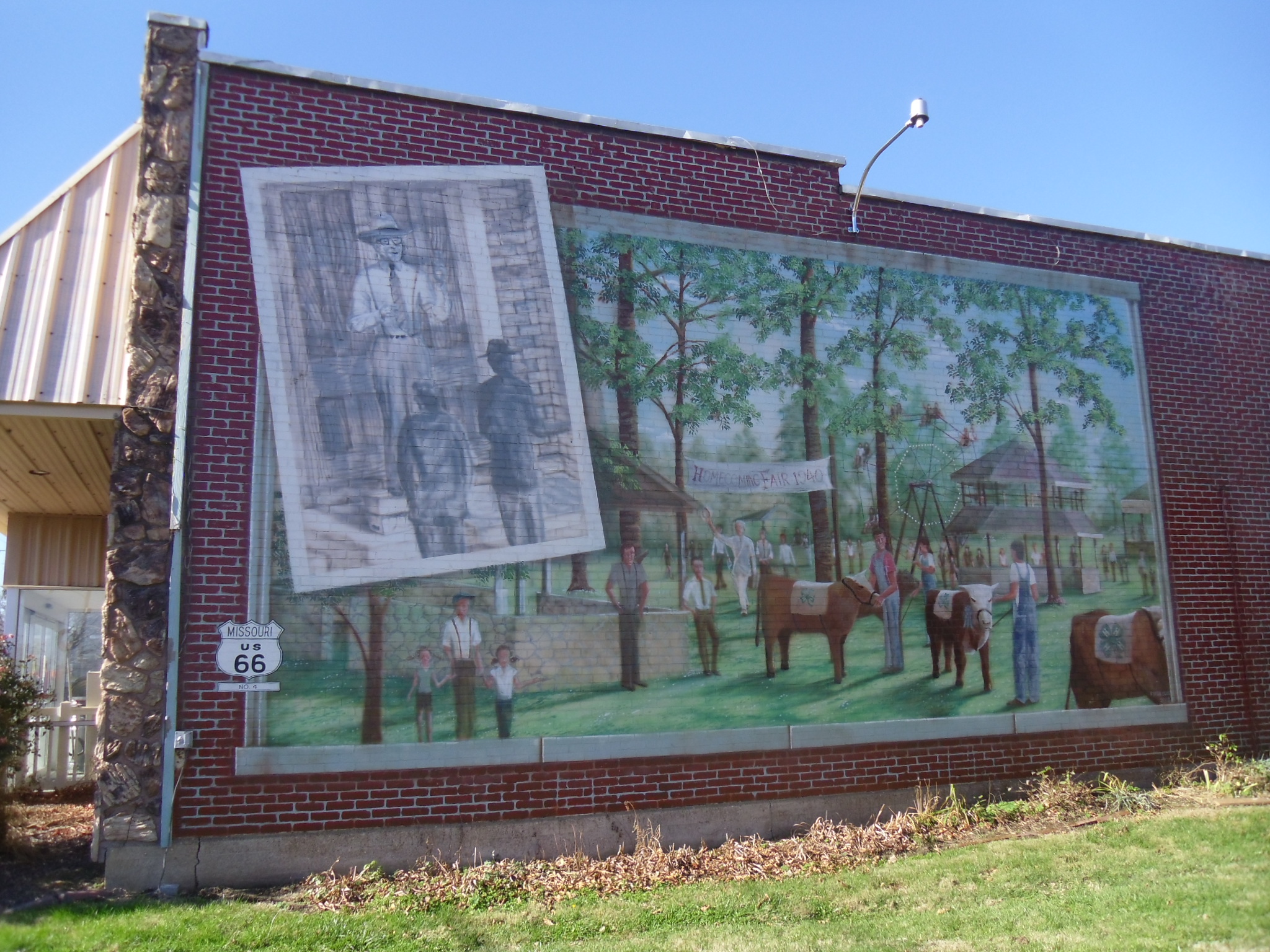 Scene from an old-time county fair
Scene from an old-time county fair Only a portion of very long mural about town history in wartime
Only a portion of very long mural about town history in wartime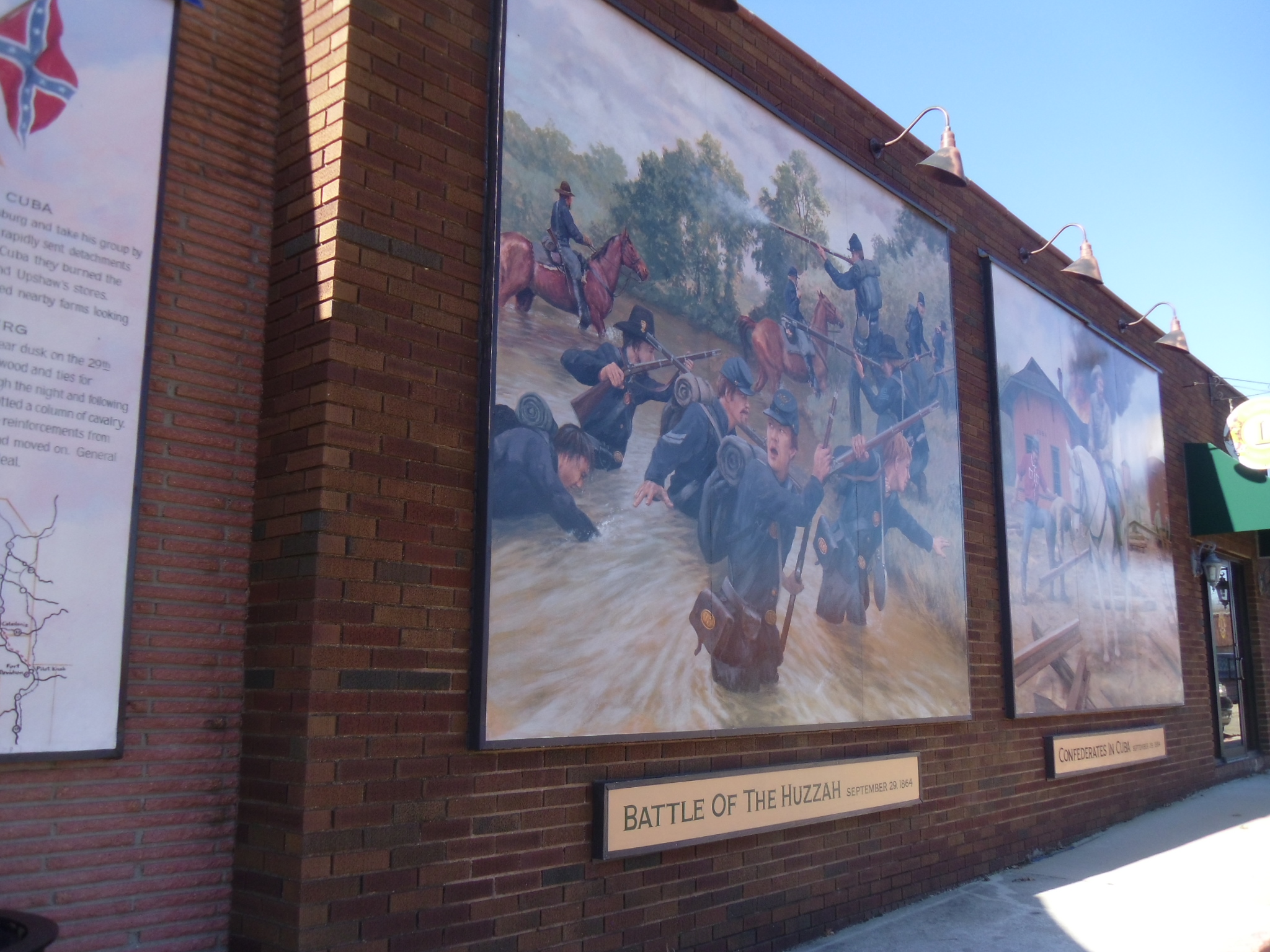 Mural about a Civil War battle impacting the community
Mural about a Civil War battle impacting the community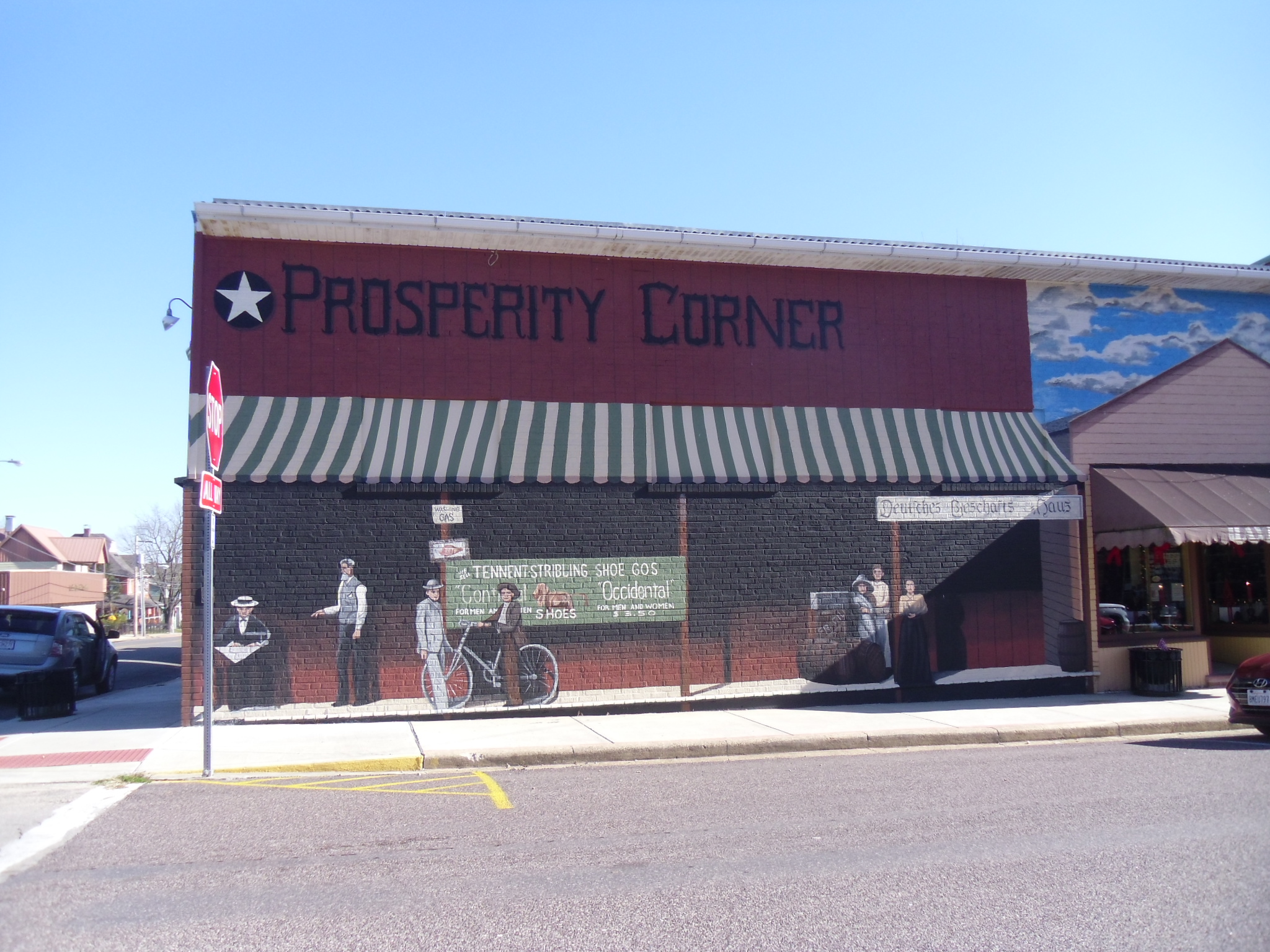 Prosperity Corner
Prosperity Corner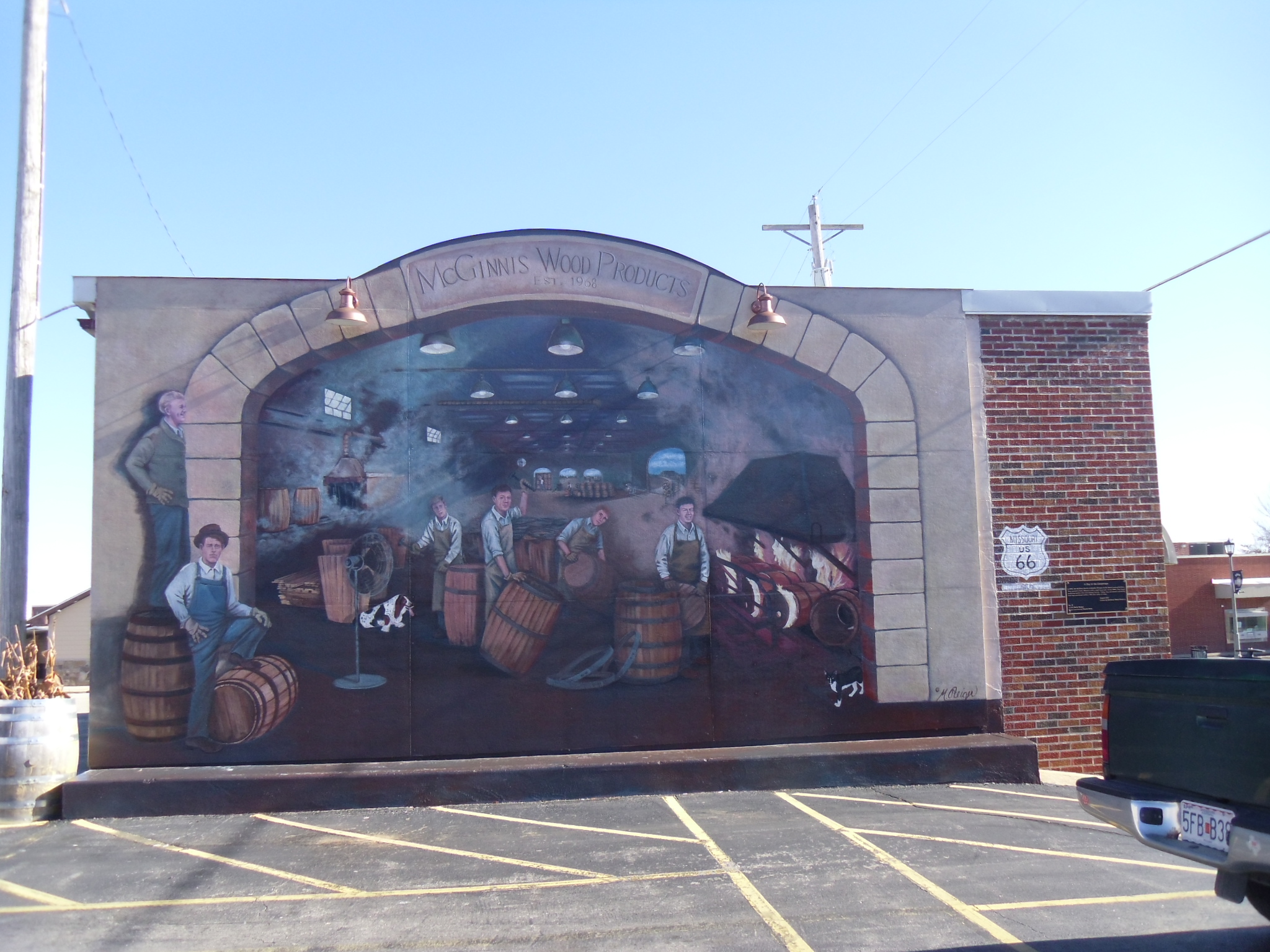 "A Day in the Cooperage" highlighting a 90-year old, ongoing business
"A Day in the Cooperage" highlighting a 90-year old, ongoing business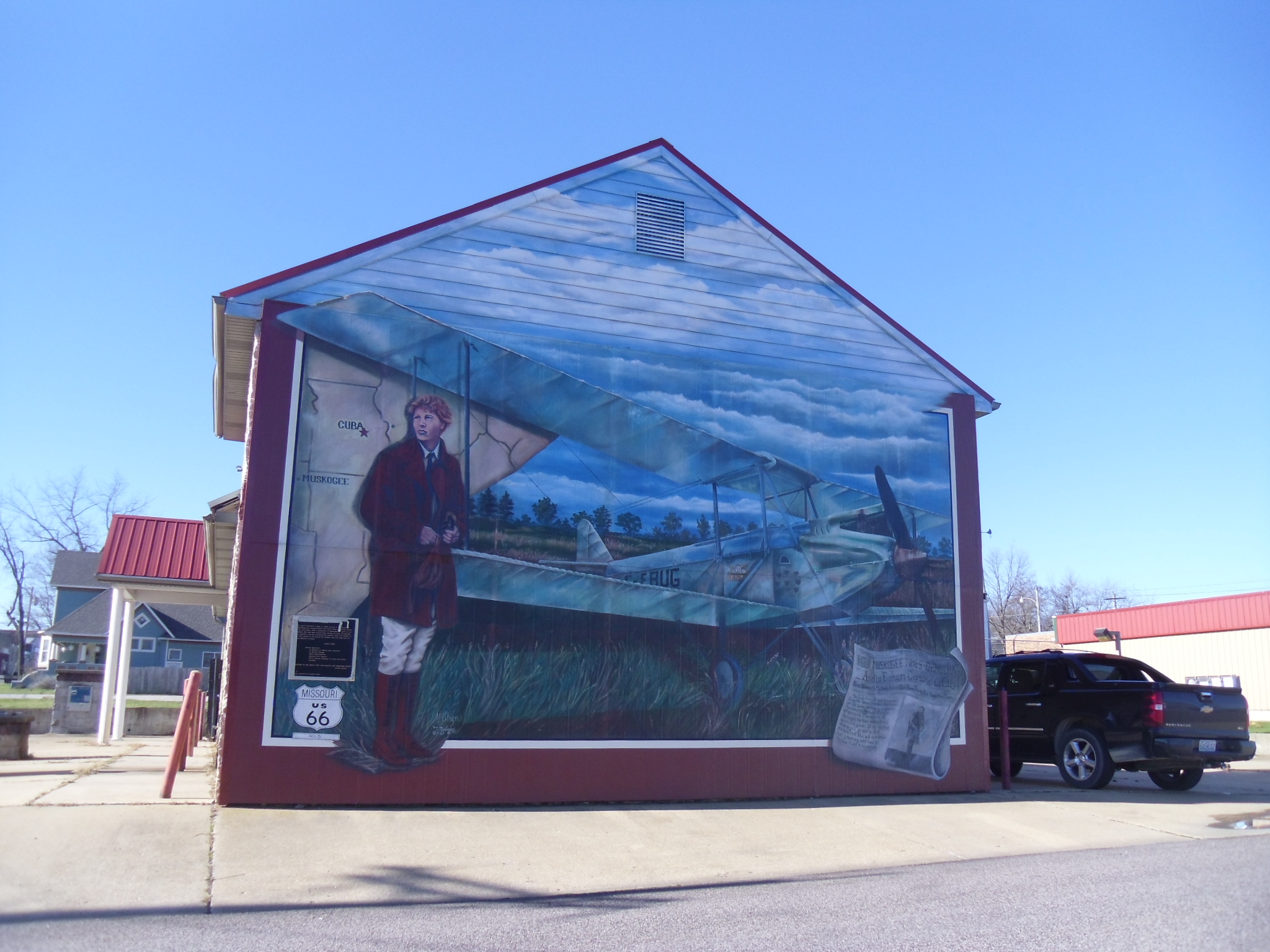 Highlighting day when Amelia Earhart made an emergency landing nearby
Highlighting day when Amelia Earhart made an emergency landing nearbyNow we promised to tell you why these murals, while very commendable, don't necessarily produce community revitalization by themselves. Without comment, see two photos at the left below. To be fair, community beautification volunteers can only take things so far; at some point businesses and the municipality have to step up with design guidelines and programs. To end on a good note, the final photo shows typical plaques associated with each mural. Many are located along historic Route 66, and the route sign is painted near the plaque that explains the history.
 Grocery store and suburban-style parking lot adjacent to one mural
Grocery store and suburban-style parking lot adjacent to one mural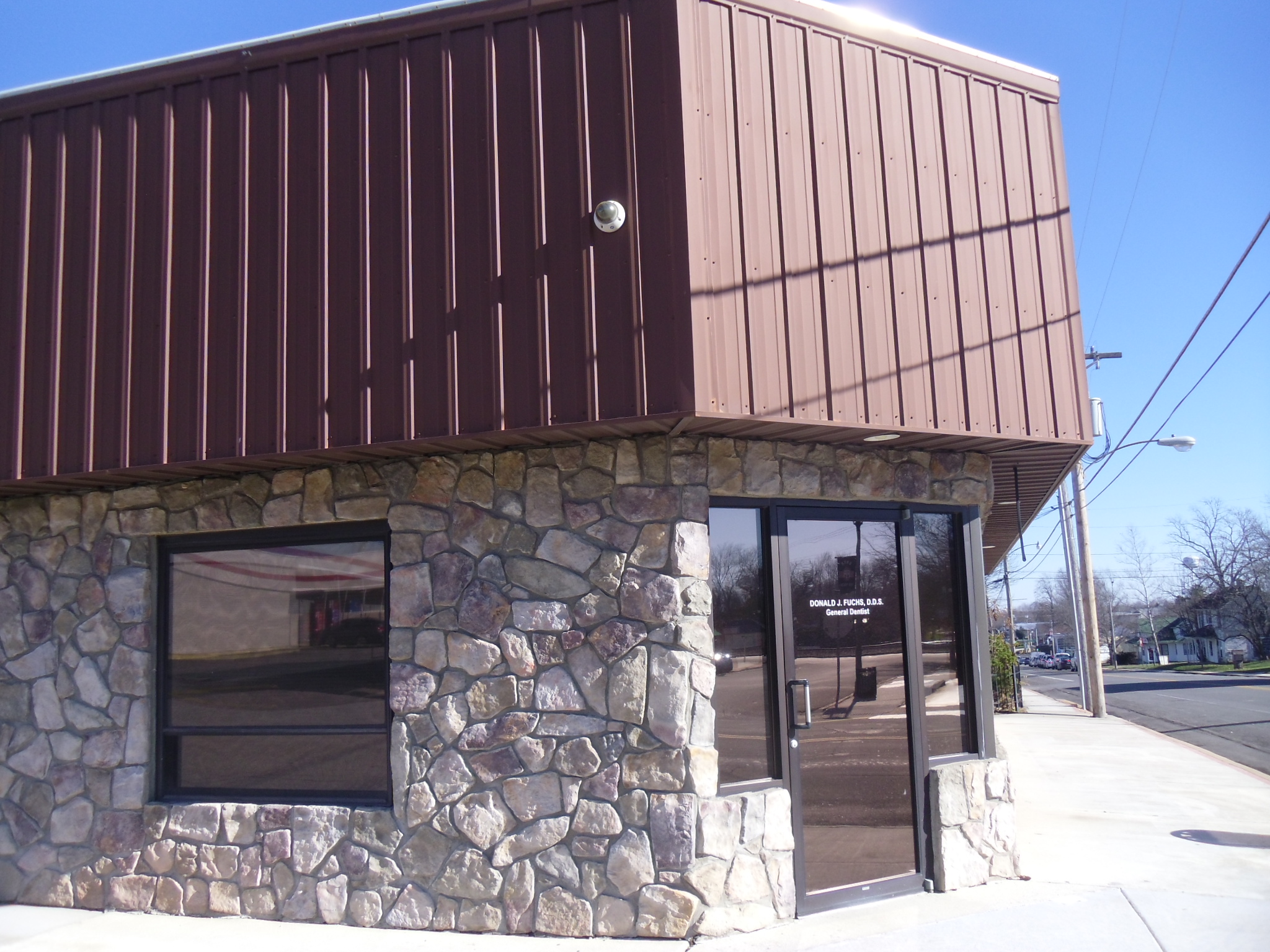 Commercial building, presumably all rock, in need of some design attention
Commercial building, presumably all rock, in need of some design attention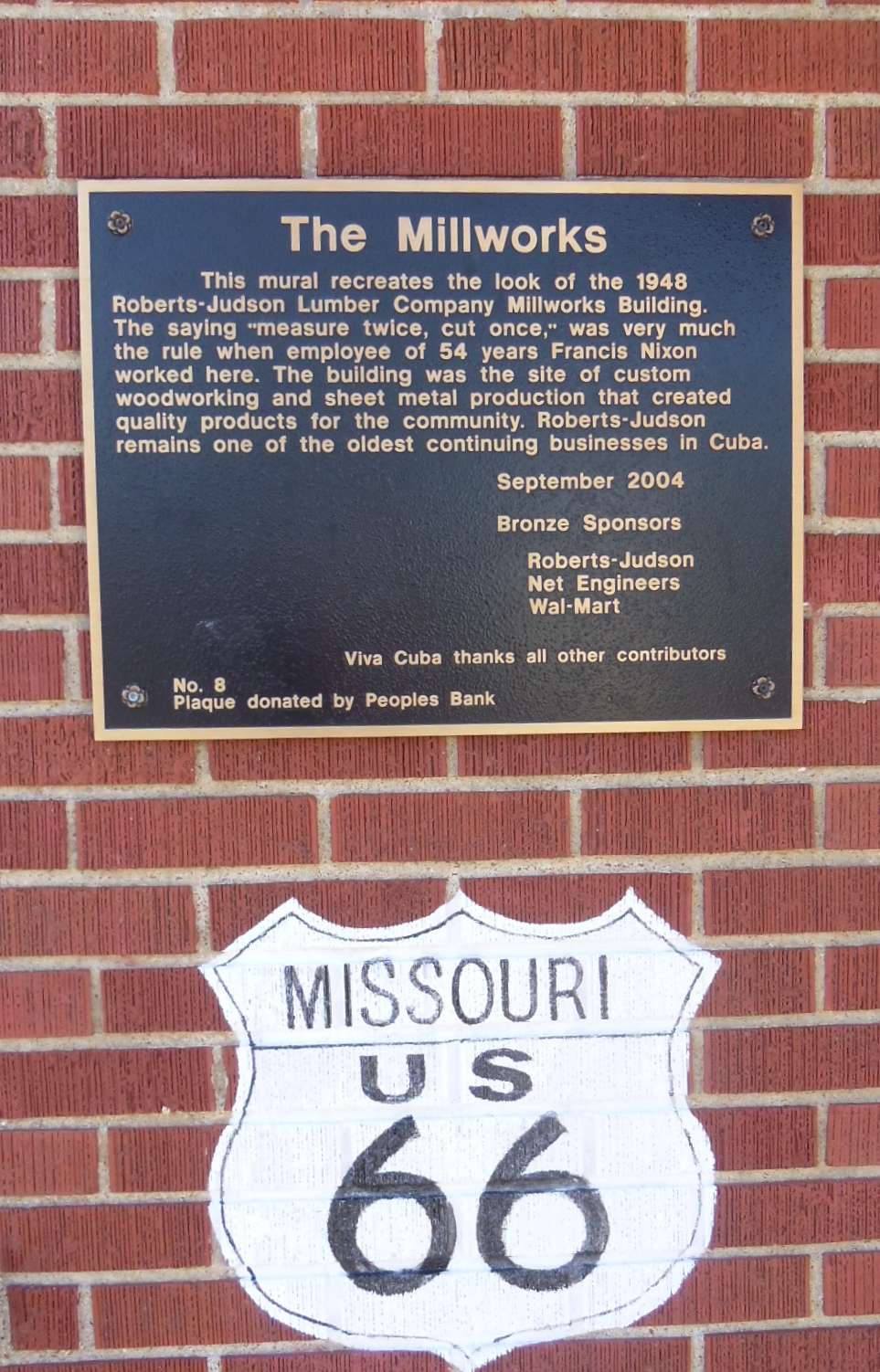 Nice historical plaque, this one with Route 66 sign below
Nice historical plaque, this one with Route 66 sign belowMurals as Part of Community Revitalization
In sum, a community mural can be very helpful in kicking off a neighborhood revitalization, neighborhood character, or business attraction campaign. If you ignore some of these precepts, you could mar your work with conflict though, so proceed carefully.
When relevant, make your mural a part of a larger project, as suggested by the following photo links.
- Making and Keeping a Good Community ›
- Community Beautification › Community Mural Advice
Join GOOD COMMUNITY PLUS, which provides you monthly with short features or tips about timely topics for neighborhoods, towns and cities, community organizations, and rural or small town environments. Unsubscribe any time. Give it a try.
